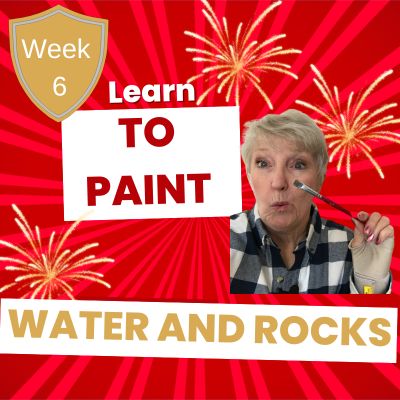Beginner’s Secret to Realistic Water And Rocks in Acrylics is what this blog post and video is all about and it’s all right here for FREE.
There’s something magical about capturing the movement of water, the shimmer of reflections, and the solid presence of rocks on canvas. But if you’re just starting out, painting these elements can feel overwhelming. Don’t worry—I’ve got you covered! In this lesson, I’ll walk you through three essential techniques that will make your water scenes come to life: using light pressure, stepping back to evaluate, and working in layers.
Want to see these techniques in action? Watch the video below and follow along as I break down each step!
1. Light Pressure Is Key
One of the biggest mistakes beginners make is pressing too hard with the brush. Water is soft, fluid, and constantly shifting—so your brushstrokes should be just as gentle! Hold your brush lightly and use feathery strokes to blend colors. If you find yourself gripping your brush like a baseball bat, take a deep breath, hold your brush further back on the handle and let the paint glide onto the canvas.
Make sure you never miss a single beginner painting lesson by signing up for my weekly one-page newsletter HERE.
2. Step Back and See the Big Picture
When you’re focused on tiny details, it’s easy to lose sight of the whole painting. Every few minutes, take a step back. What stands out? Are your reflections balanced? Do the rocks look three dimensional? Seeing your painting from a distance helps you notice what’s working (and what needs adjusting). It’s a simple habit that makes a huge difference! A painting is meant to be viewed at 6 feet, not 6 inches, so step back and see what you see.
3. Build Depth with Layers
Want your water and rocks to look more realistic? Work in layers! Start with the broadest, softest shapes, then gradually build up details. For water, begin with a transparent wash of color and slowly add highlights and reflections. For rocks, lay down your darkest values first, then layer on mid-tones and highlights. In the video I start out painting the rocks using dark browns in sloppy strokes. Then I let the highlights tell me where they are. This method creates depth and dimension, making your painting feel more alive.
Final Thoughts
Painting water, reflections, and rocks doesn’t have to be intimidating. With light pressure, a little perspective, and a layering approach, you’ll create landscapes that feel natural and full of depth. So grab your brushes, take your time, and enjoy the process—because the more you practice, the better (and more confident) you’ll become!
Click HERE if you haven’t watched the video yet.
Thanks so much for being here today. I’d love to have you sign up for my weekly one page newsletter where we talk art techniques, places around the globe to view art and artists i know and follow. I’m giving away a notebook with one of my paintings on the cover to one lucky new subscriber. It could be you.
Click HERE to see one of the many classes I have on my website.

